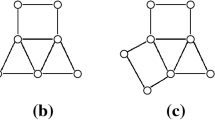Abstract
In this paper, we consider the problem of finding an induced cycle passing through k given vertices, which we call the induced cycle problem. The significance of finding induced cycles stems from the fact that a precise characterization of perfect graphs would require understanding the structure of graphs without an odd induced cycle and its complement. There has been huge progress in the recent years, especially, the Strong Perfect Graph Conjecture was solved in [6]. Concerning recognition of perfect graphs, there had been a long-standing open problem for detecting an odd hole and its complement, and finally this was solved in [4].
Unfortunately, the problem of finding an induced cycle passing through two given vertices is NP-complete in a general graph [2]. However, if the input graph is constrained to be planar and k is fixed, then the induced cycle problem can be solved in polynomial time [11]–[13]. In particular, an O(n 2) time algorithm is given for the case k=2 by McDiarmid, Reed, Schrijver and Shepherd [14], where n is the number of vertices of the input graph.
Our main results in this paper are to improve their result in the following sense.
-
1.
The number of vertices k is allowed to be non-trivially super constant number, up to \( k = o\left( {\left( {\tfrac{{\log n}} {{\log \log n}}} \right)^{\tfrac{2} {3}} } \right) \). More precisely, when \( k = o\left( {\left( {\tfrac{{\log n}} {{\log \log n}}} \right)^{\tfrac{2} {3}} } \right) \), then the ICP can be solved in O(n 2+ɛ) time for any ɛ > 0.
-
2.
The time complexity is linear if k is fixed.
We note that the linear time algorithm (the second result) is independent from the first result.
Let us observe that if k is as a part of the input, then the problem is still NP-complete, and so we need to impose some condition on k.
Similar content being viewed by others
References
S. Arnborg and A. Proskurowski: Linear time algorithms for NP-hard problems restricted to partial k-trees, Discrete Applied Math. 23 (1989), 11–24.
D. Bienstock: On the complexity of testing for even holes and induced odd paths, Discrete Math. 90 (1991), 85–92.
H. L. Bodlaender: A linear time algorithm for finding tree-decompositions of small treewidth, SIAM Journal on Computing25 (1996), 1305–1317.
M. Chudnovsky, G. Cornuéjols, X. Liu, P. D. Seymour and K. Vušković: Recognizing Berge graphs, Combinatorica25(2) (2005), 143–186.
M. Chudnovsky, K. Kawarabayashi and P. D. Seymour: Detecting even holes, Journal of Graph Theory48 (2005), 85–111.
M. Chudnovsky, N. Robertson, P. D. Seymour and R. Thomas: The strong perfect graph theorem, Annals of Mathematics64 (2006), 51–219.
M. Conforti, G. Cornuéjols, A. Kapoor and K. Vušković: Even-hole-free graphs. I. Decomposition theorem; Journal of Graph Theory39 (2002), 6–49.
M. Conforti, G. Cornuéjols, A. Kapoor and K. Vušković: Even-hole-free graphs, II. Recognition algorithm; Journal of Graph Theory40 (2002), 238–266.
M. R. Fellows: The Robertson-Seymour Theorems: a survey of applications; in: Comtemporary Mathematics, Vol. 89, pp. 1–18, American Mathematical Society, 1987.
M. R. Fellows, J. Kratochvil, M. Middendorf and F. Pfeiffer: The complexity of induced minors and related problems, Algorithmica13 (1995), 266–282.
K. Kawarabayashi and Y. Kobayashi: A linear time algorithm for the induced disjoint paths problem in planar graphs, manuscript.
K. Kawarabayashi and Y. Kobayashi: The induced disjoint paths problem, in: Proceedings of the 13th Integer Programming and Combinatorial Optimization Conference (LNCS 5035), 2008, pp. 47–61.
Y. Kobayashi: Induced disjoint paths problem in a planar digraph, Discrete Applied Math. 157 (2009), pp. 3231–3238.
C. McDiarmid, B. Reed, A. Schrijver and B. Shepherd: Induced circuits in planar graphs, Journal of Combinatorial Theory Ser. B60 (1994), 169–176.
B. Mohar and C. Thomassen: Graphs on Surfaces, The Johns Hopkins University Press, Baltimore and London, 2001.
B. Reed: Rooted routing in the plane, Discrete Applied Math. 57 (1995), 213–227.
B. A. Reed, N. Robertson, A. Schrijver and P. D. Seymour: Finding disjoint trees in planar graphs in linear time, in: Contemporary Mathematics, Vol. 147, pp. 295–301, American Mathematical Society, 1993.
N. Robertson and P. D. Seymour: Graph minors, VII. Disjoint paths on a surface; Journal of Combinatorial Theory Ser. B45 (1988), 212–254.
N. Robertson and P. D. Seymour: Graph minors, XI. Circuits on a surface; Journal of Combinatorial Theory Ser. B60 (1994), 72–106.
N. Robertson and P. D. Seymour: Graph minors, XIII. The disjoint paths problem; Journal of Combinatorial Theory Ser. B63 (1995), 65–110.
N. Robertson and P. D. Seymour: Graph minors. XXII. Irrelevant vertices in linkage problems, manuscript.
N. Robertson, P. D. Seymour and R. Thomas: Quickly excluding a planar graph, Journal of Combinatorial Theory Ser. B62 (1994), 323–348.
Author information
Authors and Affiliations
Rights and permissions
About this article
Cite this article
Kawarabayashi, Ki., Kobayashi, Y. Algorithms for finding an induced cycle in planar graphs. Combinatorica 30, 715–734 (2010). https://doi.org/10.1007/s00493-010-2499-x
Received:
Revised:
Published:
Issue Date:
DOI: https://doi.org/10.1007/s00493-010-2499-x




